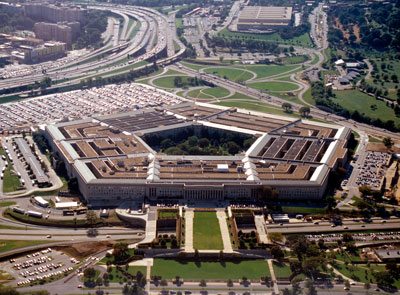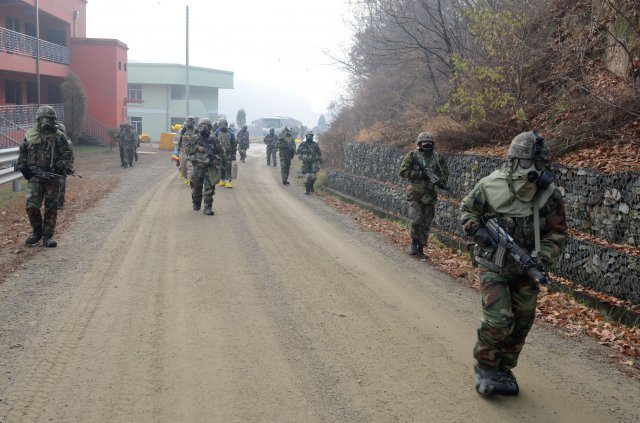The Defense Department’s senior leaders announced changes today in the Office of the Secretary of Defense and the Joint Staff designed to save money and better align the department’s structures and resources.
Defense Secretary Chuck Hagel and Army Gen. Martin E. Dempsey, chairman of the Joint Chiefs of Staff, discussed decisions made as part of the Strategic Choices and Management Review during a press briefing here.
“With the Pentagon confronting historically deep and steep, and abrupt spending reductions after a decade of significant budget growth,” Hagel said, “there is a clear need and an opportunity … to pare back overhead and streamline headquarters across this department.”
“And that is a result of, really, an era of post-9/11 that we have appropriately been focused on … to secure this country.”
Hagel explained how the Strategic Choices and Management Review, led by former Air Force Secretary Michael B. Donley, developed options to “help DOD plan for a range of future budget scenarios.”
“Included in the Strategic Choices and Management Review was a comprehensive look at a savings,” he said, “all savings that could be achieved by reducing overhead throughout the department and streamlining organizations, including OSD and the Joint Staff.”
Hagel’s briefing today was a follow up to his announcement several months ago that DOD would reduce major headquarters operating budgets by 20 percent over the next five years.
“These reductions are only a first step in DOD’s efforts to realign defense spending to meet new fiscal realities and strategic priorities,” he said.
Hagel noted these were “difficult, but necessary choices” on compensation reform, force structure, acquisitions, and other major parts of DOD to remain ahead for the department.
“These choices will be much more difficult if Congress fails to halt sequestration and fully fund the president’s budget request,” he said.
Hagel said he directed each of his principal staff assistants to begin implementing their plans to meet the 20 percent budget reductions by fiscal year 2019.
“The OSD reductions are comprehensive, touching many aspects of our organization, personnel and resources,” he said.
The defense secretary laid out eight OSD reductions in accordance with the review and announced the following changes:
- Restructuring of the Office of the Undersecretary of Defense for Policy, based on an extensive internal review of the organization, led by the current undersecretary defense for policy, Jim Miller.
- Realignment of the Office of the Director of Administration and Management, and its components, under the DCMO structure to provide better coordination and integration of DOD’s business affairs, including performance management and compliance, to result in a much stronger and more empowered deputy chief management officer.
- The transfer of specific responsibility for business information technology systems from the DCMO to DOD’s chief information officer in order to strengthen DOD’s ability to address growing IT and cyber challenges.
- Combining the Office of the Assistant to the Secretary of Defense for Intelligence Oversight, and the Defense Privacy and Civil Liberties Offices into a single office aligned under the new DCMO organization
- The Office of Net Assessment will report to the undersecretary of defense for policy to better ensure its long-range comparative analysis.
- A rebalancing of resources by the acting undersecretary of defense for personnel and readiness across the office’s three assistant secretaries of defense in order to sharpen P&R’s focus on force management, force readiness, and military health care and military compensation and retirement reform.
- Planning will move forward for the undersecretary of defense for intelligence on how its mission and focus should evolve after the drawdown of the post-9/11 conflicts, including staffing levels, organizations, and programs.
- Approved plans for eliminating the five remaining deputy undersecretaries of defense who are not appointed by the President or Senate confirmed, fulfilling direction from the Congress.
Hagel said to further improve the management of OSD, he is directing additional longer-term follow-up actions, and directing a bi-annual review to establish a regular assessment of the office’s requirements.
“Most of the reductions in OSD staff that I’ve announced today will occur through a process of natural attrition in order to minimize the impact on our workforce,” he said. “If the department is forced to take the steep sequestration cuts on the order of $500 billion over the next 10 years, we may need to implement additional reductions.”
Dempsey noted some things would have been done “whether or not we were faced with the Budget Control Act.”
“So just as he’s directed the Office of the Secretary of Defense to make these changes, so, too, will the Joint Staff, the combatant commanders, the service chiefs, as well as three-star headquarters and above throughout the world,” he said.
The chairman cited pay compensation and health care as areas that “for some time” needed adjustment or slowing of their rate of growth. In addition, excess infrastructure needs consolidation or closing, and acquisition reform, he said, needs to “get out of this pattern where things are acquired and delivered too slowly and too expensively.”
“We can’t do that ourselves,” Dempsey said. “We’re going to need help across virtually each one of these areas, and we’ll be looking to gain support for that over time.”
More broadly, the chairman lauded the department for its versatility as “we entered our 13th year of combat in Afghanistan,” while simultaneously delivering supplies to the Philippines in the aftermath of Typhoon Haiyan, and maintaining a steady state of presence in the Arabian Gulf, in the Eastern Mediterranean, and in the Pacific as well as other diplomatic efforts.
“So as we consider how to maintain our military strength, we must always remember our real strategic advantage,” Dempsey said. “That [is], of course, the men and women who serve in uniform.”
“And so the purpose of all of the reform efforts that we’ve been describing here is aimed at ensuring that we preserve and actually enhance the leadership training and equipping of our forces,” he said.
“In so doing – and only in so doing,” Dempsey said, “will we be sure to keep our nation immune from coercion.”










